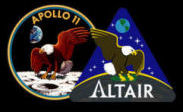|
While none of the teams were invited to the National Fly-off in May, we
are proud of our accomplishments. All teams had a valid good qualification score. Here is what we achieved.
Team 1 (7157)
Flight 1, 775ft, 34.06sec, score 46.88
Flight 2, 728ft, 38.14sec, score 35.72
Team 2 (7158)
Flight 1, 673ft, 36.87sec, score 95.26
Flight 2, 744ft, 34.81sec, score 26.38
Team 3 (7159)
Launch 1, 715ft, 55sec, score about 55, but disqualified due to broken egg
Launch 2, 777ft, 54.75sec, score 46.50
The cutoff for the TARC National Fly-Off was a
score of 17.6, which is very difficult to hit consistently.
This year, there were several successes that we
are proud of…
- I think we have a relatively successful ejection charge construction process. We had about 8 successful charges deploy the chutes. We had only a few failures of ejection charges, but because we had a backup, we didn't crash.
- We transitioned to a rail launch system. The videos show much straighter launches than in the past.
Rails and rails buttons from now on.
- We didn't lose our developed rockets. We had a few crashes, but recovered. In qualification rounds we flew all three of our primary rockets. We built structurally sound rockets. We didn't lose any in the trees, because we were careful (and maybe lucky).
- We had few broken eggs. We had nose cones free
fall from 700ft and the eggs survived. We flew with eggs all the time, and learned from last year.
And areas for improvements…
- We had problems with consistent motor operations and performance. We assembled some motors poorly and paid a price. I think this is something we can correct by focusing on the issue. We also had performance inconsistencies between motors of the same model. We purchased them from several vendors, and from different manufacturing lots. We might be able to address this is we knew which motor we planned to use much earlier in the process – like January. And I think that was a big problem with the motors this year. We tried too many different motors and by the time we decided on a motor, we could not get enough of them in time.
- We need to get started earlier. We passed up some launch opportunities in November and December in which we should have done some experiments.
- We had problems picking the right chute for the specific ejection delays and situations. Our decent times could have been better. We may want to focus more on the chutes.
- We didn't grow the project any this year. We lost a lot of seniors last year and will lose more this year. We need to focus on recruiting new members and integrating them into the program. We lost some new kids because we didn't bring them along with learning tasks.
And there is always next year, when we will learn to control our rocket
and win the challenge! Thanks to all the parents who helped drive. I know it can be long days and uncertain return times. And the weather can frustrate us even more. But this program needs some parents to drive.
|



